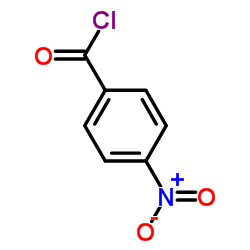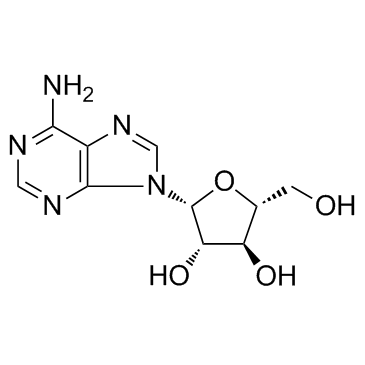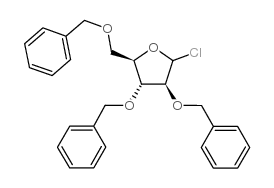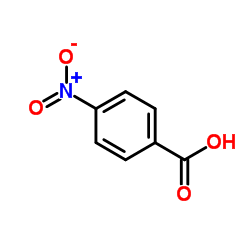52522-49-3
| 中文名 | 2,3,5-三-O-苄基-D-阿拉伯呋喃糖-1-(4-硝基苯甲酸酯) |
|---|---|
| 英文名 | 2,3,5-tri-O-benzyl-1,0-(4-nitrobenzoyl)-D-arabinofuranose |
| 中文别名 | 1-对硝基苯甲酸-2,3,5-三苄氧基-D-阿拉伯呋喃糖苷 |
| 英文别名 |
2,3,5-tri-O-benzyl-1-O-(p-nitrobenzoyl)-D-arabinofuranose
2,3,5-TRI-O-BENZYL-D-ARABINOFURANOSE-1 2,3,5-Tri-O-benzyl-D-arabinofuranose 1-(4-nitrobenzoate) 2,3,5-Tri-O-benzyl-1-O-(4-nitrobenzoyl)-D-arabinofuranose D-Arabinofuranose, 2,3,5-tris-O-(phenylmethyl)-, 4-nitrobenzoate 1-O-(4-nitrobenzoyl)-2,3,5-tri-O-benzyl-D-arabinofuranose MFCD00038477 2,3,5-tri-O -benzyl-1-O-p-nitrobenzoyl-D-arabinofuranose 2,3,5-tri-O-benzyl-1-(4-nitrobenzoyloxy)-D-arabinofuranose 4-nitrobenzoate 2,3,5-tris-O-benzyl-D-arabinofuranose EINECS 257-992-5 |
| 密度 | 1.3±0.1 g/cm3 |
|---|---|
| 沸点 | 706.2±60.0 °C at 760 mmHg |
| 熔点 | 69-72ºC |
| 分子式 | C33H31NO8 |
| 分子量 | 569.601 |
| 闪点 | 246.8±34.9 °C |
| 精确质量 | 569.204956 |
| PSA | 109.04000 |
| LogP | 8.36 |
| 外观性状 | 无气味的灰白色粉末 |
| 蒸汽压 | 0.0±2.2 mmHg at 25°C |
| 折射率 | 1.631 |
| 储存条件 | 密封、在 -20 ºC下保存 |
| 稳定性 | 如果遵照规格使用和储存则不会分解,未有已知危险反应 |
| 计算化学 | 1、 疏水参数计算参考值(XlogP):5.6 2、 氢键供体数量:0 3、 氢键受体数量:8 4、 可旋转化学键数量:13 5、 互变异构体数量:未确定 6、 拓扑分子极性表面积(TPSA):106 7、 重原子数量:42 8、 表面电荷:0 9、 复杂度:809 10、 同位素原子数量:0 11、 确定原子立构中心数量:0 12、 不确定原子立构中心数量:4 13、 确定化学键立构中心数量:0 14、 不确定化学键立构中心数量:0 15、 共价键单元数量:1 |
| 更多 | 1. 性状:粉末 2. 密度(g/mL,25ºC):未确定 3. 相对蒸汽密度(g/mL,空气=1): 未确定 4. 熔点(ºC):70-79 5. 沸点(ºC):未确定 6. 沸点(ºC,13mm hg):未确定 7. 折射率:未确定 8. 闪点(°F):未确定 9. 比旋光度(ºC):未确定 10. 自燃点或引燃温度(ºC): 未确定 11. 蒸气压(kPa,20ºC):未确定 12. 饱和蒸气压(kPa,60ºC):未确定 13. 燃烧热(KJ/mol):未确定 14. 临界温度(ºC):未确定 15. 临界压力(KPa):未确定 16. 油水(辛醇/水)分配系数的对数值:未确定 17. 爆炸上限(%,V/V):未确定 18. 爆炸下限(%,V/V):未确定 19. 溶解性:未确定 |
Synonym:None Section 2 - COMPOSITION, INFORMATION ON INGREDIENTS
Risk Phrases: None Listed. Section 3 - HAZARDS IDENTIFICATION EMERGENCY OVERVIEW
The toxicological properties of this material have not been fully investigated. Potential Health Effects Eye: May cause eye irritation. Skin: May cause skin irritation. Ingestion: May cause irritation of the digestive tract. The toxicological properties of this substance have not been fully investigated. Inhalation: May cause respiratory tract irritation. The toxicological properties of this substance have not been fully investigated. Chronic: No information found. Section 4 - FIRST AID MEASURES Eyes: Flush eyes with plenty of water for at least 15 minutes, occasionally lifting the upper and lower eyelids. Get medical aid. Skin: Get medical aid. Flush skin with plenty of water for at least 15 minutes while removing contaminated clothing and shoes. Wash clothing before reuse. Ingestion: Never give anything by mouth to an unconscious person. Get medical aid. Do NOT induce vomiting. If conscious and alert, rinse mouth and drink 2-4 cupfuls of milk or water. Wash mouth out with water. Inhalation: Remove from exposure and move to fresh air immediately. If not breathing, give artificial respiration. If breathing is difficult, give oxygen. Get medical aid. Notes to Physician: Section 5 - FIRE FIGHTING MEASURES General Information: As in any fire, wear a self-contained breathing apparatus in pressure-demand, MSHA/NIOSH (approved or equivalent), and full protective gear. During a fire, irritating and highly toxic gases may be generated by thermal decomposition or combustion. Extinguishing Media: Use agent most appropriate to extinguish fire. Use water spray, dry chemical, carbon dioxide, or appropriate foam. Section 6 - ACCIDENTAL RELEASE MEASURES General Information: Use proper personal protective equipment as indicated in Section 8. Spills/Leaks: Vacuum or sweep up material and place into a suitable disposal container. Clean up spills immediately, observing precautions in the Protective Equipment section. Avoid generating dusty conditions. Provide ventilation. Section 7 - HANDLING and STORAGE Handling: Wash thoroughly after handling. Use with adequate ventilation. Minimize dust generation and accumulation. Avoid contact with eyes, skin, and clothing. Keep container tightly closed. Avoid ingestion and inhalation. Storage: Store in a tightly closed container. Store in a cool, dry, well-ventilated area away from incompatible substances. Section 8 - EXPOSURE CONTROLS, PERSONAL PROTECTION Engineering Controls: Facilities storing or utilizing this material should be equipped with an eyewash facility and a safety shower. Use adequate ventilation to keep airborne concentrations low. Exposure Limits CAS# 52522-49-3: Personal Protective Equipment Eyes: Wear appropriate protective eyeglasses or chemical safety goggles as described by OSHA's eye and face protection regulations in 29 CFR 1910.133 or European Standard EN166. Skin: Wear appropriate protective gloves to prevent skin exposure. Clothing: Wear appropriate protective clothing to prevent skin exposure. Respirators: A respiratory protection program that meets OSHA's 29 CFR 1910.134 and ANSI Z88.2 requirements or European Standard EN 149 must be followed whenever workplace conditions warrant respirator use. Section 9 - PHYSICAL AND CHEMICAL PROPERTIES Physical State: Powder Color: off-white powder Odor: odorless pH: Not available. Vapor Pressure: Not available. Viscosity: Not available. Boiling Point: Not available. Freezing/Melting Point: 69-72C Autoignition Temperature: Not applicable. Flash Point: Not applicable. Explosion Limits, lower: Not available. Explosion Limits, upper: Not available. Decomposition Temperature: Solubility in water: Specific Gravity/Density: Molecular Formula: C33H31NO8 Molecular Weight: 569.2189 Section 10 - STABILITY AND REACTIVITY Chemical Stability: Stable under normal temperatures and pressures. Conditions to Avoid: Incompatible materials, dust generation, excess heat. Incompatibilities with Other Materials: Oxidizing agents. Hazardous Decomposition Products: Carbon monoxide, irritating and toxic fumes and gases, carbon dioxide. Hazardous Polymerization: Will not occur. Section 11 - TOXICOLOGICAL INFORMATION RTECS#: CAS# 52522-49-3 unlisted. LD50/LC50: Not available. Carcinogenicity: 2,3,5-Tri-O-benzyl-1-O-(4-Nitrobenzoyl)-D-Arabinofuranose - Not listed by ACGIH, IARC, or NTP. Section 12 - ECOLOGICAL INFORMATION Section 13 - DISPOSAL CONSIDERATIONS Dispose of in a manner consistent with federal, state, and local regulations. Section 14 - TRANSPORT INFORMATION IATA Not regulated as a hazardous material. IMO Not regulated as a hazardous material. RID/ADR Not regulated as a hazardous material. Section 15 - REGULATORY INFORMATION European/International Regulations European Labeling in Accordance with EC Directives Hazard Symbols: Not available. Risk Phrases: Safety Phrases: S 24/25 Avoid contact with skin and eyes. S 28A After contact with skin, wash immediately with plenty of water. S 37 Wear suitable gloves. S 45 In case of accident or if you feel unwell, seek medical advice immediately (show the label where possible). WGK (Water Danger/Protection) CAS# 52522-49-3: No information available. Canada None of the chemicals in this product are listed on the DSL/NDSL list. CAS# 52522-49-3 is not listed on Canada's Ingredient Disclosure List. US FEDERAL TSCA CAS# 52522-49-3 is not listed on the TSCA inventory. It is for research and development use only. SECTION 16 - ADDITIONAL INFORMATION N/A |
|
生态学数据: 对水是稍微有危害的不要让未稀释或大量的产品接触地下水、水道或者污水系统,若无政府许可,勿将材料排入周围环境
|
|
~% 
52522-49-3 |
| 文献:Kadir, Kamaliah; Mackenzie, Grahame; Shaw, Gordon Journal of the Chemical Society, Perkin Transactions 1: Organic and Bio-Organic Chemistry (1972-1999), 1980 , p. 2304 - 2309 |
| 上游产品 2 | |
|---|---|
| 下游产品 4 | |







![5-amino-1-[3,4-dihydroxy-5-(hydroxymethyl)oxolan-2-yl]imidazole-4-carboxamide结构式](https://image.chemsrc.com/caspic/132/37642-57-2.png)